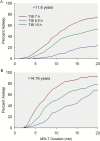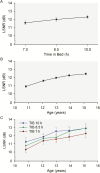Differential and interacting effects of age and sleep restriction on daytime sleepiness and vigilance in adolescence: a longitudinal study
- PMID: 30169721
- PMCID: PMC7191880
- DOI: 10.1093/sleep/zsy177
Differential and interacting effects of age and sleep restriction on daytime sleepiness and vigilance in adolescence: a longitudinal study
Abstract
Study objectives: There is contradictory evidence on whether sleep need decreases across adolescence. We investigated this question longitudinally with a dose-response design to test the effects of varied sleep durations on daytime sleepiness and on vigilance and to test whether these relations change with age across early and mid-adolescence.
Methods: Data from 76 participants who completed at least 2 years of the 3-year study are included in this report. Annually, participants ranging in age from 9.8 to 16.2 years completed three different time in bed (TIB) schedules each consisting of four consecutive nights of 7, 8.5, or 10 hours. Daytime sleepiness (multiple sleep latency test [MSLT]) and vigilance (psychomotor vigilance test [PVT]) were measured on the day following the fourth night of each TIB schedule.
Results: Electroencephalogram (EEG)-measured sleep durations changed linearly with TIB. MSLT-measured daytime sleepiness decreased with longer TIB and increased with age. The TIB and age effects interacted such that the TIB effect decreased with age. PVT performance improved with longer TIB and improved with age, but the benefit that increased TIB conferred on PVT performance did not change with age.
Conclusions: These results seem paradoxical because daytime sleepiness increased but vigilance improved with age. The significant age effect on the relation between TIB and sleepiness compared to the lack of an age effect on the relation between TIB and vigilance performance suggests different rates of maturation in underlying brain systems. We interpret these findings in relation to our model of adolescent brain development driven by synaptic elimination.
Figures



Similar articles
-
Neurobehavioral dynamics following chronic sleep restriction: dose-response effects of one night for recovery.Sleep. 2010 Aug;33(8):1013-26. doi: 10.1093/sleep/33.8.1013. Sleep. 2010. PMID: 20815182 Free PMC article. Clinical Trial.
-
The effect of split sleep schedules (6h-on/6h-off) on neurobehavioural performance, sleep and sleepiness.Appl Ergon. 2016 May;54:72-82. doi: 10.1016/j.apergo.2015.12.004. Epub 2015 Dec 21. Appl Ergon. 2016. PMID: 26851466
-
Daytime Sleepiness Increases With Age in Early Adolescence: A Sleep Restriction Dose-Response Study.Sleep. 2017 May 1;40(5):zsx046. doi: 10.1093/sleep/zsx046. Sleep. 2017. PMID: 28419388 Free PMC article. Clinical Trial.
-
The multiple sleep latency test.Handb Clin Neurol. 2019;160:393-403. doi: 10.1016/B978-0-444-64032-1.00026-6. Handb Clin Neurol. 2019. PMID: 31277864 Review.
-
Objective evaluation of excessive daytime sleepiness.Neurophysiol Clin. 2024 Apr;54(2):102938. doi: 10.1016/j.neucli.2023.102938. Epub 2024 Feb 23. Neurophysiol Clin. 2024. PMID: 38401239 Review.
Cited by
-
Associations among sleep, hematologic profile, and aerobic and anerobic capacity of young swimmers: A complex network approach.Front Physiol. 2022 Aug 24;13:948422. doi: 10.3389/fphys.2022.948422. eCollection 2022. Front Physiol. 2022. PMID: 36091363 Free PMC article.
-
Maturational trend of daytime sleep propensity in adolescents.Sleep. 2024 Jan 11;47(1):zsad263. doi: 10.1093/sleep/zsad263. Sleep. 2024. PMID: 37798133 Free PMC article.
-
Sleep restriction and age effects on waking alpha EEG activity in adolescents.Sleep Adv. 2022 May 10;3(1):zpac015. doi: 10.1093/sleepadvances/zpac015. eCollection 2022. Sleep Adv. 2022. PMID: 35669317 Free PMC article.
-
Earlier Bedtime and Its Effect on Adolescent Sleep Duration.Pediatrics. 2023 Jul 1;152(1):e2022060607. doi: 10.1542/peds.2022-060607. Pediatrics. 2023. PMID: 37305962 Free PMC article.
-
Sleep restriction effects on sleep spindles in adolescents and relation of these effects to subsequent daytime sleepiness and cognition.Sleep. 2023 May 10;46(5):zsad071. doi: 10.1093/sleep/zsad071. Sleep. 2023. PMID: 36916319 Free PMC article.
References
-
- Iglowstein I, et al. . Sleep duration from infancy to adolescence: reference values and generational trends. Pediatrics. 2003;111(2):302–307. - PubMed
-
- Shinkoda H, et al. . Sleep-wake habits of schoolchildren according to grade. Psychiatry Clin Neurosci. 2000;54(3):287–289. - PubMed
-
- Wolfson AR, et al. . Sleep schedules and daytime functioning in adolescents. Child Dev. 1998;69(4):875–887. - PubMed
Publication types
MeSH terms
Grants and funding
LinkOut - more resources
Full Text Sources
Other Literature Sources

